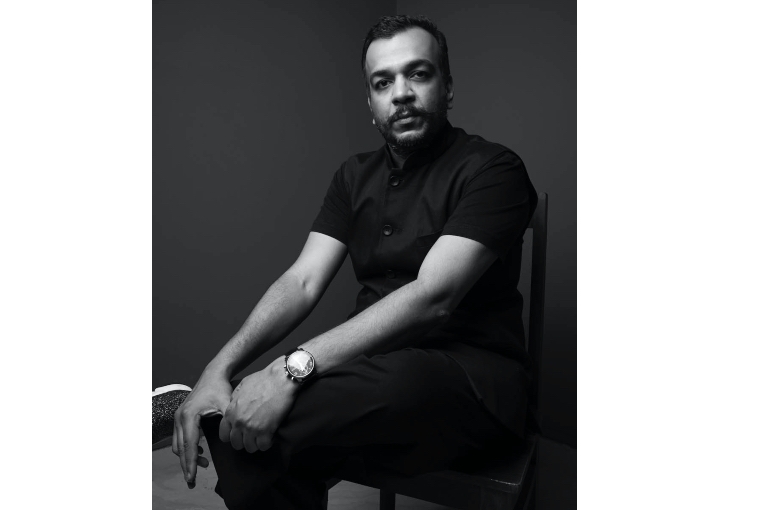

The Amit Aggarwal aesthetic needs no introduction. Deft futuristic artistry rooted in a utilitarian structure, makes his designs one of a kind. The designer’s most recent endeavour involved a limited edition t-shirt collection, launched in an attempt to support the karigars in his atelier. Called Interdependence all of the t-shirts were named after their creators, the karigars. Amit’s efforts come at a time when the need to champion indigenous craftsmanship is more important than ever, to not only protect it from being lost in oblivion, but also to help those crumbling under the pressure of the pandemic. Each of the pieces, sustainable in their spirit, have been created using fabric and print patches leftover from production processes.
In conversation with the designer about his sensibility and evolution as a designer, the relation between a karigar and a designer, and the Interdependence collection, amongst other things.
The Amit Aggarwal avant-garde couture that we know today is unique and one of a kind. How would you describe your design sensibility?
The core of our couture lies in modern craftsmanship and elevating traditional techniques by utilising industrial materials. We always focus on working with an eclectic mix of tradition and innovation, rendering each garment with our signature progressive aesthetic, and inculcating the sensitivity towards the planet in our daily functioning. Our brand has always envisioned clothes for a strong, confident woman, who loves to celebrate herself.
Tell us about what motivated the limited edition collection and how would you describe the relation between a karigar and a designer?
We thought of utilising a lot of leftover fabrics, trims and print patches from production processes which were recovered from the shop floor post the lockdown. We wanted to use them to create a small capsule of shirts solely by the interdependence of the entire team of karigars. To let them create pieces based on each other’s strengths, without the involvement of a design or production team, ultimately empowering their togetherness and allowing more support and respect for one another, especially during these times. The entire idea was not only of the design being interdependent on the karigar community, but a wholesome idea of all of us being interdependent on each other in order to create. This feeling was rooted in equality and the realisation that most karigars come from small villages and live away from their families for livelihood, spending a lifetime to bring our vision to life. That’s why I feel employing indigenous strengths of weavers, karigars and embroiders is one of the most important ways of building strengths.
Fashion, as we know it, is dead and reshaping itself right now. What is your take on the new normal for the fashion industry once we come out of this pandemic?
Change is the only constant and adapting to it is the only key. No one could have predicted how the world has stood still, and us with it. To progress further, one has to keep up with changing times and mould yourself to it. We have to shift towards more modern and newer workmanship, employing the strength of local craftsmen, emphasising on intricacies, finesse and quality of the product, that finally is targeted toward better customer service. The future of fashion will be built on rightfully taking care of the craftsmen, investing in training them to produce meticulously made pieces and eliminating excessive production in the post-pandemic era. We have committed to sustainability from the beginning of our company and we continue to envision progressing towards a more sustainable way of running a fashion house.

Who/What inspires you to create at a time like this?
A challenge to change and adapt is utmost exciting. It keeps me evolving myself and the language of the brand.
You have been a part of the industry for more than a decade now. How do you think you have evolved as a designer?
My creative journey started with collections that were fiercely driven by my independent thinking process, however the last decade has brought in a higher level of malleability to my own self. Absorbing, understanding and reflecting upon the point of view of customers, my own sales and production team have made me evolve from just being inspirational, but equally aspirational too. It gives me immense joy to strike a balance between creative and commerce, and create a new vision for wedding couture all over the world.
Lastly, what’s coming up next?
We are working on launching our digital store to facilitate customers, it would include an exclusive bridal couture collection and Luxury Prét collections, along with our classic pieces.

Text Unnati Saini